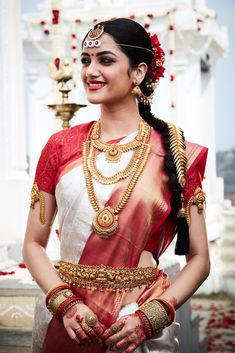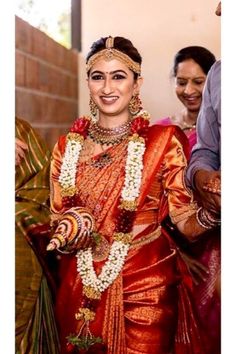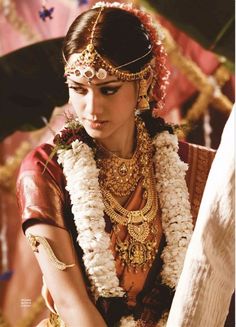Karnataka Bridal
In the vibrant tapestry of Indian culture, the Karnataka bridal attire stands out with its unique blend of tradition, elegance, and symbolism. Karnataka, a state in southern India, boasts a rich cultural heritage reflected in its weddings. From the intricate details of attire to the rituals and customs, each aspect contributes to the beauty and significance of Karnataka bridal attire.

Attire: The Karnataka bridal attire is a visual spectacle, blending traditional craftsmanship with modern sensibilities. The bride adorns herself in a rich silk saree, often in vibrant colors like red, green, or gold. The silk saree holds immense cultural significance, symbolizing prosperity and auspiciousness. Embellished with intricate zari work, embroidery, and motifs inspired by nature and mythology, the saree is a masterpiece of craftsmanship.
Accompanying the saree is the traditional jewelry, which adds a touch of opulence to the bridal ensemble. The bride wears elaborate necklaces, earrings, bangles, and waistbands crafted from gold, pearls, and precious gemstones. These jewels not only enhance the bride’s beauty but also serve as symbols of wealth, status, and blessings for a prosperous married life.
Hairstyle and Makeup: The Karnataka bride’s hairstyle and makeup are carefully curated to complement her attire and enhance her natural beauty. Traditional hairstyles like the jasmine-adorned bun or the classic braid adorned with flowers are popular choices among Karnataka brides. These hairstyles not only exude elegance but also hold cultural significance, symbolizing purity and auspiciousness.
Makeup plays a subtle yet crucial role in completing the bridal look. The emphasis is on enhancing the bride’s features while maintaining a natural, radiant glow. Soft, earthy tones are preferred for eyeshadow and lipstick, complementing the overall traditional aesthetic of the bridal ensemble.

Accessories: In addition to jewelry, Karnataka brides adorn themselves with a myriad of accessories that hold cultural and religious significance. The maang tikka, worn on the forehead, symbolizes the bride’s marital status and serves as a blessing for a happy and prosperous union. The nose ring, known as nath, is another essential accessory, symbolizing beauty and fertility.
Rituals and Customs: Karnataka weddings are steeped in age-old rituals and customs that add depth and meaning to the celebration. From the pre-wedding rituals like Nischay Tamulam (engagement ceremony) to the post-wedding rituals like Grihapravesha (welcoming the bride to her new home), each ceremony is a reflection of Karnataka’s cultural heritage.
One of the most significant rituals is the Kashi Yatra, where the groom pretends to leave for Kashi (a sacred city) in pursuit of knowledge, only to be stopped by the bride’s family, symbolizing their willingness to accept him into their fold. Another notable ritual is the Saptapadi, where the bride and groom take seven symbolic steps together, each step representing a vow they make to each other for a lifelong partnership.
Conclusion: In conclusion, the Karnataka bridal attire is a testament to the rich cultural heritage and traditions of the state. From the elaborate silk sarees to the intricate jewelry and timeless rituals, every aspect of the Karnataka bridal ensemble is infused with symbolism and significance. As Karnataka continues to embrace modernity, the timeless allure of its bridal attire remains a cherished part of its cultural identity.



